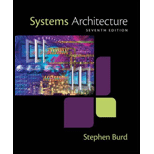
Systems Architecture
7th Edition
ISBN: 9781305080195
Author: Stephen D. Burd
Publisher: Cengage Learning
expand_more
expand_more
format_list_bulleted
Concept explainers
Expert Solution & Answer
Chapter 4, Problem 3RQ
Explanation of Solution
Special-purpose registers
- Special-purpose registers are used to store state information about machine/ change state configuration.
- Each special purpose register is designated for a purpose...
Explanation of Solution
Examples of special-purpose registers
The three examples of special-purpose registers include
- Instruction register
- When the control unit fetches an instruction from memory, it is stored in the instruction register...
Expert Solution & Answer
Want to see the full answer?
Check out a sample textbook solution
Students have asked these similar questions
You have made the Web solution with Node.js. please let me know what problems and benefits I would experience while making the Web solution here, as compared to any other Web solution you have developed in the past.
what problems and benefits/things to keep in mind as someone just learning
PHP is the server-side scripting language. MySQL is used with PHP to store all the data. EXPLAIN in details how to install and run the PHP/MySQL on your computer. List the issues and challenges I may encounter while making this set-up?
why I asked: I currently have issues logging into http://localhost/phpmyadmin/ and I tried using the command prompt in administrator to reset the password but I got the error LOCALHOST PORT not found.
HTML defines content, CSS defines layout, and JavaScript adds logic to the website on the client side. EXPLAIN IN DETAIL USING an example.
Chapter 4 Solutions
Systems Architecture
Ch. 4 - Prob. 1VECh. 4 - ________________ generates heat in electrical...Ch. 4 - Prob. 3VECh. 4 - Prob. 4VECh. 4 - Prob. 5VECh. 4 - One _________________ is one cycle per second.
Ch. 4 - Prob. 7VECh. 4 - When an instruction is first fetched from memory,...Ch. 4 - Prob. 9VECh. 4 - Prob. 10VE
Ch. 4 - Prob. 11VECh. 4 - Prob. 12VECh. 4 - The contents of a memory location are copied to a...Ch. 4 - Prob. 14VECh. 4 - A(n) ________________ instruction always alters...Ch. 4 - Prob. 16VECh. 4 - A(n) ____________________ instruction copies data...Ch. 4 - The CPU incurs one or more _________________ when...Ch. 4 - The CPU incurs one or more _____ when its idle,...Ch. 4 - In many CPUs, a register called the _____ stores...Ch. 4 - The components of an instruction are its _____ and...Ch. 4 - Two 1-bit values generate a 1 result value when...Ch. 4 - A(n) _____ operation transforms a 0 bit value to 1...Ch. 4 - _____ predicts that transistor density will double...Ch. 4 - A(n) _____ is a measure of CPU or computer system...Ch. 4 - _____ is a CPU design technique in which...Ch. 4 - Describe the operation of a MOVE instruction. Why...Ch. 4 - Prob. 2RQCh. 4 - Prob. 3RQCh. 4 - Prob. 4RQCh. 4 - Prob. 5RQCh. 4 - Prob. 7RQCh. 4 - Prob. 8RQCh. 4 - Prob. 9RQCh. 4 - How does pipelining improve CPU efficiency? What’s...Ch. 4 - Prob. 11RQCh. 4 - Develop a program consisting of primitive CPU...Ch. 4 - If a microprocessor has a cycle time of 0.5...Ch. 4 - Processor R is a 64-bit RISC processor with a 2...Ch. 4 - Prob. 4PECh. 4 - Prob. 1RPCh. 4 - Prob. 2RPCh. 4 - Prob. 3RP
Knowledge Booster
Learn more about
Need a deep-dive on the concept behind this application? Look no further. Learn more about this topic, computer-science and related others by exploring similar questions and additional content below.Similar questions
- show all the workarrow_forwardList down the strenghts and weaknesses of your team project for Capsim Simulation? Explan.arrow_forwardCapsim Team PowerPoint Presentations - Slide Title: Key LearningsWhat were the key learnings that you discovered as a team through your Capsim simulation?arrow_forward
- Write the SQL code that permits to implement the tables: Student and Transcript. NB: Add the constraints on the attributes – keys and other.arrow_forwardDraw an ERD that will involve the entity types: Professor, Student, Department and Course. Be sure to add relationship types, key attributes, attributes and multiplicity on the ERD.arrow_forwardDraw an ERD that represents a book in a library system. Be sure to add relationship types, key attributes, attributes and multiplicity on the ERD.arrow_forward
arrow_back_ios
SEE MORE QUESTIONS
arrow_forward_ios
Recommended textbooks for you
 Systems ArchitectureComputer ScienceISBN:9781305080195Author:Stephen D. BurdPublisher:Cengage Learning
Systems ArchitectureComputer ScienceISBN:9781305080195Author:Stephen D. BurdPublisher:Cengage Learning Principles of Information Systems (MindTap Course...Computer ScienceISBN:9781285867168Author:Ralph Stair, George ReynoldsPublisher:Cengage Learning
Principles of Information Systems (MindTap Course...Computer ScienceISBN:9781285867168Author:Ralph Stair, George ReynoldsPublisher:Cengage Learning Enhanced Discovering Computers 2017 (Shelly Cashm...Computer ScienceISBN:9781305657458Author:Misty E. Vermaat, Susan L. Sebok, Steven M. Freund, Mark Frydenberg, Jennifer T. CampbellPublisher:Cengage Learning
Enhanced Discovering Computers 2017 (Shelly Cashm...Computer ScienceISBN:9781305657458Author:Misty E. Vermaat, Susan L. Sebok, Steven M. Freund, Mark Frydenberg, Jennifer T. CampbellPublisher:Cengage Learning Database Systems: Design, Implementation, & Manag...Computer ScienceISBN:9781305627482Author:Carlos Coronel, Steven MorrisPublisher:Cengage Learning
Database Systems: Design, Implementation, & Manag...Computer ScienceISBN:9781305627482Author:Carlos Coronel, Steven MorrisPublisher:Cengage Learning C++ for Engineers and ScientistsComputer ScienceISBN:9781133187844Author:Bronson, Gary J.Publisher:Course Technology Ptr
C++ for Engineers and ScientistsComputer ScienceISBN:9781133187844Author:Bronson, Gary J.Publisher:Course Technology Ptr

Systems Architecture
Computer Science
ISBN:9781305080195
Author:Stephen D. Burd
Publisher:Cengage Learning

Principles of Information Systems (MindTap Course...
Computer Science
ISBN:9781285867168
Author:Ralph Stair, George Reynolds
Publisher:Cengage Learning

Enhanced Discovering Computers 2017 (Shelly Cashm...
Computer Science
ISBN:9781305657458
Author:Misty E. Vermaat, Susan L. Sebok, Steven M. Freund, Mark Frydenberg, Jennifer T. Campbell
Publisher:Cengage Learning


Database Systems: Design, Implementation, & Manag...
Computer Science
ISBN:9781305627482
Author:Carlos Coronel, Steven Morris
Publisher:Cengage Learning

C++ for Engineers and Scientists
Computer Science
ISBN:9781133187844
Author:Bronson, Gary J.
Publisher:Course Technology Ptr